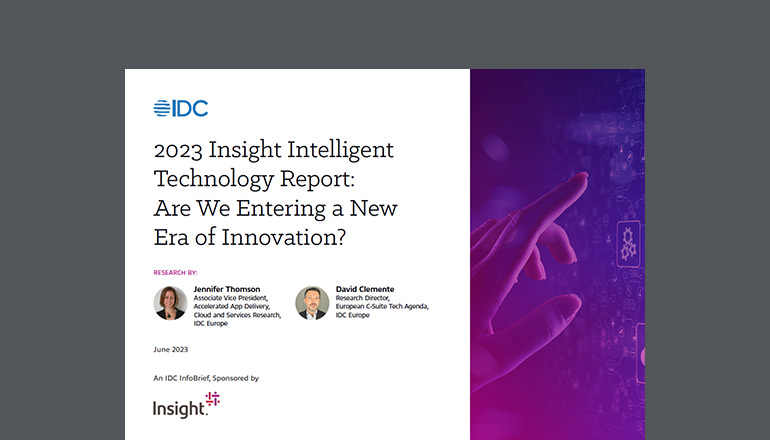Tech Journal 3 Key Challenges Facing Business Optimisation — And How a Technology Partner Can Help
By Bob Bogle / 26 Oct 2021 / Topics: Devices IT optimization Software

Leveraging trending technology can optimise your business costs and operations — but how do you navigate the constant evolution? With the right tools and technology partner, your business can reach its full potential.
The impact of COVID-19 across industries has driven business optimisation at an unprecedented pace. Virtually overnight, companies were forced to design and execute highly complex projects, including remote work, infrastructure adaptations, digital modernisation and additional security layers to support rapid change. To ensure resilience, organisations have been tasked with overcoming these challenges and more, all while growing and supporting the company.
As pandemic restrictions change, many businesses are permanently transitioning to a hybrid workforce environment: a mix of on-site and remote employees, modern digital experiences, and on-demand access to software and solutions. With this shift, optimisation across the new IT landscape becomes critical. IT departments worked tirelessly to implement urgent transformations in 2020; we'll need to reexamine where those systems stand today, as well as areas for enhancement.
Navigating a post-pandemic world will come with its share of additional challenges, and strategic optimisation can reframe the future of business.
But let’s take a step back: What exactly is business optimisation, and how does it apply to you? At Insight, we look at optimisation as the process of improving the efficiency, productivity and performance of an organisation. This can apply both to internal operations and external products. Big data and connective technology can be used to influence new approaches that drive business optimisation — allowing organisations to achieve more.
Optimising your business may look like:
- Reducing costs with improved productivity
- Enhancing cybersecurity with modern tools
- Utilising advanced software to streamline operations
- Applying new onboarding systems for hybrid workers
At the heart of each optimisation lies one crucial benefit: speed. By improving the pace at which you accomplish goals, you’ll save valuable time — and the old saying holds true: Time is money.
By leveraging trending technology, you’ll optimise costs, achieve your goals and thrive in an evolving digital world.
There’s a new ask of IT: Be the innovators. Technology teams are expected to function as a profit centre, rather than a cost centre. So, how do you optimise costs and increase output? It’s all about the right technology.
Let’s explore three key challenges in today’s technology that are apt for optimisation.
1. Heightened cybersecurity
When it comes to key risks facing businesses today, it’s impossible to overemphasise the importance of security. The rapid transition to remote and hybrid work brought about an urgent need for heightened cyber defense. In today’s world, becoming a victim of a cyberattack is a matter of when, not if.
A cyberattack can bring down your entire IT system, resulting in extreme financial loss, damaged reputation and countless additional fallout. Having the most up-to-date cybersecurity in place is vital to detect, stop and respond to attacks in real time.
Particular concern in today’s hybrid world surrounds Artificial Intelligence (AI). The rise of AI in cybersecurity is rapidly evolving, and hackers are utilising its tools and reliance on the cloud for advanced cyberattacks. You’ll want to employ solutions that protect every part of your IT environment, including but not limited to:
- Endpoint security: Keep your devices safe from cyberthreats and malware — wherever you use them.
- Email security: Unlock tools such as firewalls, encryption and filtering to make it difficult for hackers to gain entry to your internal systems.
- Application security: Minimise the risk of threats, breaches and code hijacking.
- Identity and access management: Enforce appropriate access to critical systems for your workforce and customers.
There’s a vast array of solutions that can improve your protective controls, but remember: A holistic approach is always best. Ensure your strategy spans the identify, protect, detect, respond and recover categories.
2. Innovative devices and lifecycle management
Devices are essential to business operations, with billions in use today. Maintaining high workforce productivity (and improved profits) requires the right tools at the right times, and having modern, fast devices will increase employee satisfaction and retention. However, managing the device lifecycle can consume the bulk of your budget. In fact, PCs continue to make up the largest capital component in the annual IT budget for many enterprises.
So, how can you find and utilise the right tools without breaking the bank? A technology partner can eliminate the time and hassle of managing multiple hardware vendors, ensure maximum uptime and lifespan, improve user experience and reduce device total cost of ownership. We’ll talk more about the benefits of choosing the right partner below, but first, let’s look at software optimisation.
3. Software and process automation
In today’s constantly evolving digital space, having the right software to support your work is crucial to success. This is especially important if new employees are joining your organisation from a fully remote setting. With devices that are ready to go and equipped with the right software, your team will onboard with ease, and you’ll save time (and resources) from the start.
The right tools can also automate repetitive processes, eliminate redundancies and free team members to focus on important tasks. With today’s optimisations, you’ll see improvements in:
- Productivity: Business applications can streamline your operations and improve efficiency, collaboration and performance.
- Creativity: Your team can produce unparalleled work with feature-rich platforms for designing, editing, drafting and more.
- Networking: Powerful networking applications keep your users and devices connected across your business.
- Operating systems: With an efficient, robust operating system, you can seamlessly manage hardware and software resources.
Applying advanced technology tools in these areas can lead to pivotal optimisation for your business, but staying up to date with trending tech can be a job in and of itself. New technology is increasingly complex, and we’re dealing with an expanded surface area — more devices, a dispersed workforce and accelerated cloud migration.
That’s where a technology partner comes in.
Choosing the right technology partner
We’ve covered how utilising technology can optimise your business cost, processes and more — but what if you could take it one step further and optimise the entire process?
When finding the right technology for your business, you might spend valuable time juggling vendors for the right product, only to be left with no issue support, maintenance, licensing assistance and overall partnership. Procuring software, for example, can come with a host of challenges: unused products, auditing issues, duplicated technologies, wasted resources and more.
A full-service technology partner, like Insight, will subvert these challenges and bring you improved efficiency, effectiveness, compliance and strategic alignment. When you’re looking for the right partner, you’ll want to ask a few key questions:
- Do they have an extensive breadth of capabilities?
- Do they offer end-to-end solutions?
- Do they provide a seamless marriage of products and solutions?
- Are they adept in modern services and devices that support digital transformation?
The ideal technology partner will not only help you find the right technology, but also provide unmatched benefits before, after and along the way.










